My guidebook says of Bukhara, "Central Asia's holiest city has buildings spanning a thousand years of history and a thoroughly lived-in centre that probably hasn't changed much in two centuries. Most of the centre is an architectural preserve, full of former medressas, a massive, decaying royal fortress and the remnants of a once-vast market complex." March 21 is a pagan holiday in Uzbekistan, so three Americans working on USAID projects decided to take a long weekend and go see for ourselves.
On Friday morning we went to the airport in Tashkent and boarded a small plane for the one-hour flight to Bukhara. We were pleased to see a representative from our hotel ("Sasha & Son's B&B") waiting for us and he drove us to the small hotel. Sasha greeted us and proudly showed us his newly decorated hotel. All the rooms had intricate wall carvings hand painted. The rooms were small but comfortable -- Bill had to duck to get in his door. In the center was a pleasant courtyard.
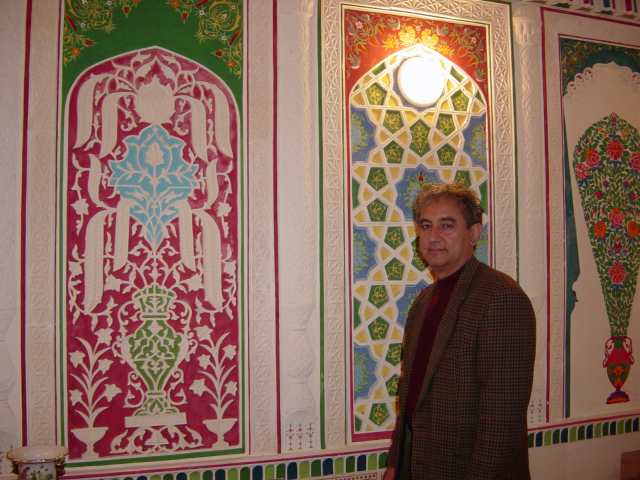
After quickly settling in and having a cup of tea we decided it was time to go exploring. We were pleased to see that cars were not permitted in the historic part of the city. We walked five minutes to Labi-Hauz, a plaza surrounding a pool that seemed to bhe center of the old city. We saw shashlik cafes around the pool, Mulberry trees that are supposed to have been planted in 1477 and huge entrances to several medressas. Medressas are schools for boys who want to study the Koran and Bukhara. Only a couple of them are currently active. The biggest one next to the pool is now a center for local craftsmen to sell their products. We also saw the statue of the "semi-mythical wise fool" who apparently plays a recurring role in Sufi stories.
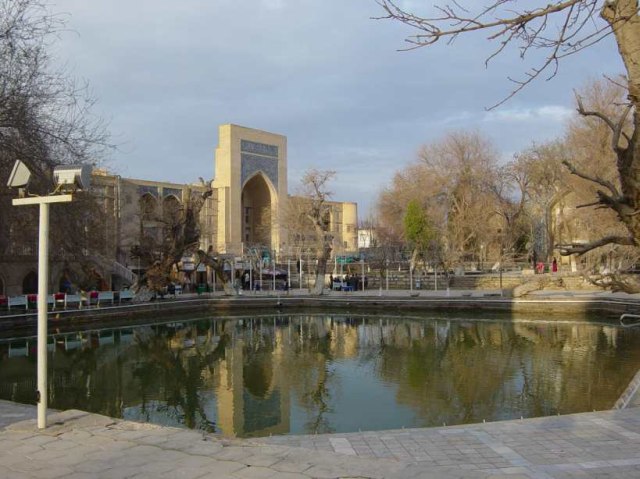

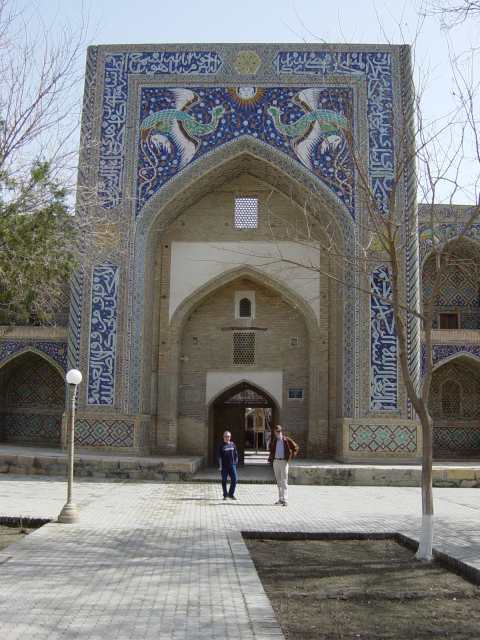
We wandered over to the Kalon Minaret, built in 1127 and still standing with only cosmetic repairs. We walked up the 47 meters and admired the view of the adjoing Kalon Mosque (only 500 years old) with space for 10,000 worshipers. The roof initially looked flat, but closer inspection revealed lots of small domes. I chose not to dispute the guidebook's claim that there are 288 of them.
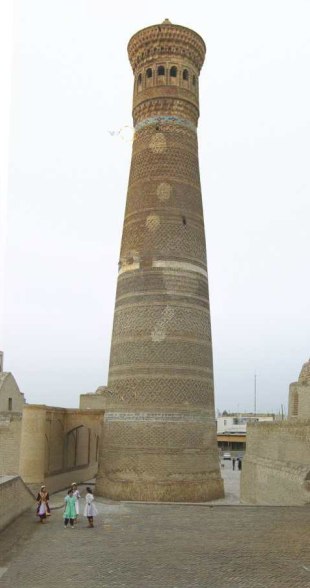

Looking out the Minaret in the other direction we saw the 16th century Mir-i-Arab Medressa with its two turquoise domes. We couldn't go in because students were hard at work. It was closed in 1920 by the Soviets, but reopened in 1944 in an attempt to gain Muslim support for the war. At the time it was the only Muslim seminary in the Soviet Union, but following independence other medressas have reopened. Now 250 young men are studying there. Like all the medressas, it has a large central courtyard surrounded by small rooms on two levels. Some of the rooms are used for classes but most are dormitories.

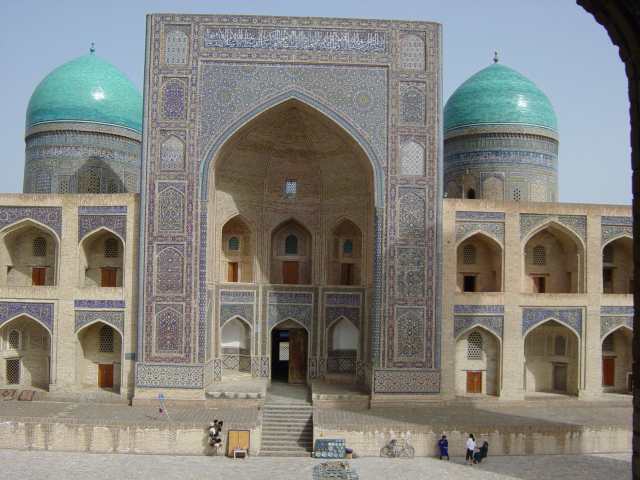
We wandered around for a while. A woman sensed that we could profit from a guide and offered her services. She showed us a mausoleum and a modern monument and told us many stories of Bukhara. I had trouble keeping up with the stories but Alan was more patient. She also gave us advice on what to see on Saturday.
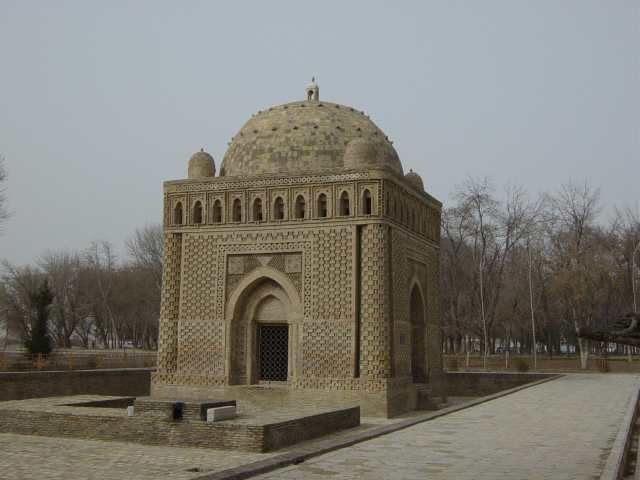
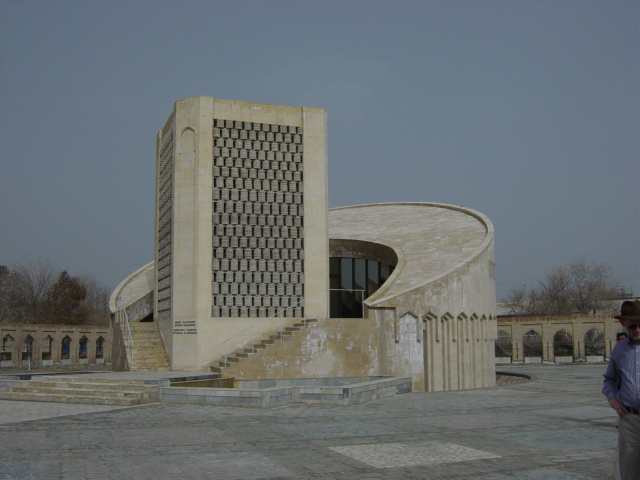
The next day we started by wandering around the narrow streets of the old city. We saw many children playing in the streets -- Uzbekistan is not suffering from the population decline of other CIS countries. Lots of children said "Hello", "What is your name?" and "Good-bye". At first we were suspicious that they would ask for money, but most of them were happy to practice their English on tourists.
Eventually we found our way to a museum of the house of the first president of the Bukhara People's Republic. The sign said only "The house of a rich Bukhara merchant" because local citizens are not proud of his role in conspiring with the Bolsheviks to overthro the Amir of Bukhara. The guides told us all about his story and showed off the decorations of the house. The museum retained many ordinary household goods from a hundred years ago, including ceramic ovens, a huge iron pot for making plov (pilav) and other cooking implements.


Then we went to a small mosque nearby. A young man saw us admiring it and went to get a key and one of the men who say prayers there. This was a neighborhood mosque where prayers are said five times a day.
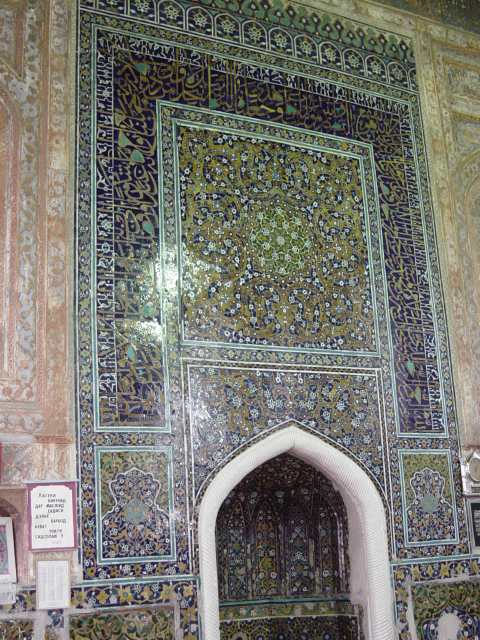
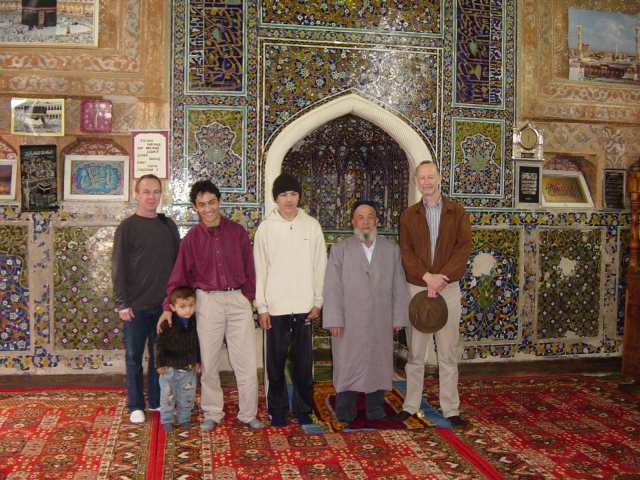
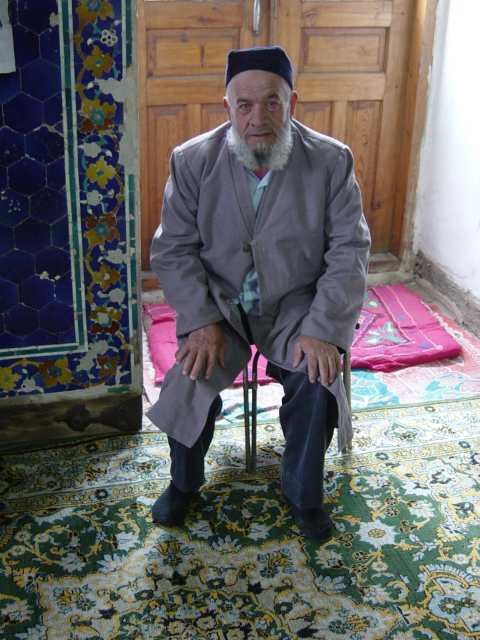
Our next stop was a fortress called the Ark. Now it has a series of museums and lots of people selling souvenirs, but it still would be difficult to enter if the occupants did not invite you! Here I look down on it from the mosque's minaret. Our guidebook explains that the Ark was continuously occupied at least from the fifth century until 1920 when the Soviet Army bombed it.
Another famous feature of the city is its Prison. In 1839 an Englishman, Col. Stoddard, came to visit the Emir to try to convince him to favor the British over the Russians and to reassure him that though the British had invaded Afghanistan they had no plans to invade Bukhara. (The British were worried that the Czar wanted to invade India by land from central Asia.) Col. Stoddard managed to offend the Emir and was thrown in prison. Two years later Capt. Connolly arrived to try to secure his release. However, by then the British had lost their war in Afghanistan and were retreating. The Emir figured he would teach the British a lesson, so he had both men beheaded. We saw a cell with dummies chained to the wall looked down into the pit where Stoddard and Connolly spent some of their imprisonment. Now people throw money into it, wishing for good luck. It won't be difficult for their luck to be better than Stoddard and Connolly's.
I wandered around another corner of the old city to find a small mosque with four minarets and domes. The minarets were as big as the rest of the mosque. I climbed up and enjoyed the view.
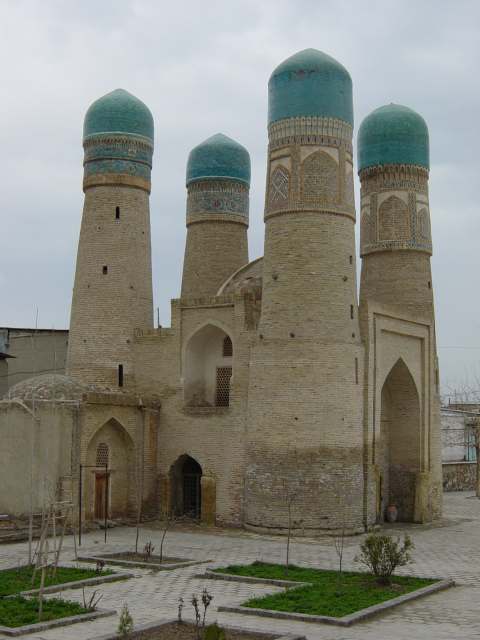
On Sunday morning we hired a taxi and went on a short excursion out of town. The first stop was a summer palace the Czar had built for the Emir at the end of the 19th century. Now it is a museum showing an interesting combination of European (Russian) and Asian styles.
We continued on to Chor-Bakr, a sixteenth century necropolis. We found two huge mosques and thousands of graves, some with elaborate decoration, some simple, some very old, some very new.
We finished our visit to Bukhara with a puppet show. The sign advertised a show at 4:00, so we showed up at the appointed place. Girls welcomed us and showed us front row seats. Soon it became apparent that we would be the only members of the audience this afternoon. The set and puppets were spectacular and they put on an excellent show of an Uzbek wedding, combining music, dance and puppetry. They never asked us to pay for the show, but we did buy some puppets. I hope they get more customers as the tourist season develops.
So we returned to the hotel where our ride to the airport was waiting, and we had an uneventful flight back to Tashkent.